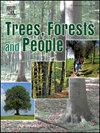Rapid spread and high prevalence of the pine wilt disease around wildfire areas
IF 2.7
Q1 FORESTRY
引用次数: 0
Abstract
Pine trees hold a vital position in South Korea's forests, yet they face significant threats due to the spread of pine wilt disease. Pine Wilt Disease (PWD) is a devastating condition that causes rapid wilting and eventual death in susceptible pine trees. Notably, given the life cycle characteristics of the pine wood nematode and its Monochamus beetle vectors, concerns are growing that wildfire-affected areas may accelerate the spread of pine wilt disease. Therefore, the objective of this study is to analyze changes in the spatial distribution of pine wilt disease before and after wildfires using inspection data and to evaluate the relative risk of infection detection rates in wildfire-affected areas. To achieve this, we analyzed data from 2016 to 2023 in Goryeong-gun, Gyeongsangbuk-do, South Korea. At the administrative district level, Global Moran's I and Local Indicators of Spatial Association (LISA) were employed, and detailed cluster analysis was conducted using SaTScan software for the post-wildfire period. The analysis revealed that clusters were formed in pre-existing outbreak areas before the wildfire, while newly significant clusters emerged around wildfire-affected areas after the wildfire. Subsequently, the standardized relative risk between wildfire-affected and non-affected areas was analyzed to quantify the difference in risk levels. The analysis indicated that wildfire-affected areas, particularly Sinchon-ri in Ssangnim-myeon, Goryeong-gun, exhibited a significantly higher relative risk of 1.87 (95 % confidence interval [CI]: 1.57–2.10). To our knowledge, this study is the first attempt to observe an increased risk of pine wilt disease spread in and around wildfire-affected areas. The findings suggest that when wildfires occur, intensified control measures should be implemented not only in directly affected areas but also in surrounding regions to effectively manage pine wilt disease.
松材枯萎病在山火地区传播迅速,流行率高
松树在韩国的森林中占有重要地位,但由于松树枯萎病的蔓延,它们面临着重大威胁。松树萎蔫病(PWD)是一种导致易感松树迅速枯萎和最终死亡的破坏性疾病。值得注意的是,考虑到松材线虫及其单足甲虫载体的生命周期特征,人们越来越担心受野火影响的地区可能加速松材枯萎病的传播。因此,本研究的目的是利用检测数据分析林火前后松树枯萎病的空间分布变化,并评价林火灾区感染检出率的相对风险。为此,我们分析了韩国庆尚北道高陵郡2016年至2023年的数据。在行政区域层面,采用Global Moran’s I和Local Indicators of Spatial Association (LISA),利用SaTScan软件对野火后时期进行详细的聚类分析。分析显示,在野火发生前,在已经存在的爆发地区形成了集群,而在野火发生后,在野火影响地区周围出现了新的重要集群。随后,对受野火影响地区和未受野火影响地区的标准化相对风险进行了分析,以量化风险水平的差异。分析表明,受野火影响的地区,特别是高岭郡双宁面Sinchon-ri的相对危险度显著高于1.87(95%可信区间[CI]: 1.57-2.10)。据我们所知,这项研究是第一次试图观察到松树枯萎病在野火影响地区及其周围传播的风险增加。研究结果表明,当森林火灾发生时,不仅要在直接受灾地区,而且要在周边地区加强控制措施,以有效管理松树枯萎病。
本文章由计算机程序翻译,如有差异,请以英文原文为准。
求助全文
约1分钟内获得全文
求助全文
来源期刊

Trees, Forests and People
Economics, Econometrics and Finance-Economics, Econometrics and Finance (miscellaneous)
CiteScore
4.30
自引率
7.40%
发文量
172
审稿时长
56 days
 求助内容:
求助内容: 应助结果提醒方式:
应助结果提醒方式:


